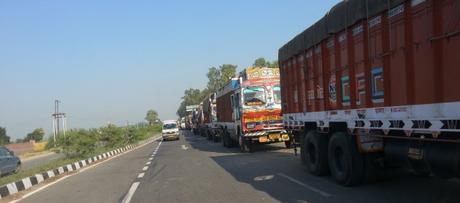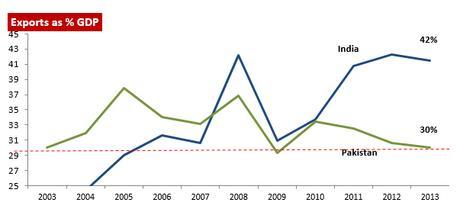
Trucks wait at the India-Pakistan border. (Photo: Wikimedia Commons)
Huma Sattar is a CIPE-Atlas Corps Think Tank LINKS Fellow at the Heritage Foundation
Pakistan and India share a long, unyielding history. The past is marred with political and territorial conflict, militarization, and a general sense of mistrust on both sides.
Since 2003, trade between the two countries has grown seven-fold, with Indian imports into Pakistan taking 80 percent of the share, according to data reported by International Trade Centre. While formal figures report bilateral trade of U.S $2.3 billion for 2013, some estimates contend that a larger share of bilateral trade between Pakistan and India comes through indirect or informal routes. Trade is estimated to be double what statistics report with significant Indian imports coming through Dubai into Pakistan.
Many studies which have aimed to estimate potential bilateral trade between Pakistan and India have concluded consistently that there are enormous economic synergies that can exist between the two economies given their trade complementarity and geographic proximity. Mutually preferential cooperation would benefit both Pakistan and India.
However, Pakistan has still not granted Most Favored Nation status (MFN) to India despite talks that seemed to have made progress in the past few years. Judging by the recent statements made by officials from Pakistan, it seems the country will remain flummoxed by the idea of granting MFN to India, contending one or more of the following as reason for their reservations:
- India gave MFN to Pakistan in 1996. For Pakistan, however, the trade deficit has only increased.
- MFN to India will hurt the local economy of Pakistan.
- Increasing trade with India has hardened India’s stance on Kashmir.
Unfortunately for Pakistan, the merits of these arguments are wearing thin. In fact, putting the Kashmir issue and trade on the same table ensures that neither side relents and both issues remain unaddressed.
Is the trade deficit a bad thing?
India is a rising star in the global market. The Economist notes that India’s GDP rose by 7.5 percent in 2014, ‘a shade faster’ than China’s economy over the same period. The fact that India is growing faster than Asia’s giant is testament to where it could be in the next decade or so. India’s economy is eight times bigger than Pakistan’s and continues to grow with vigor. And it has lower costs of production, so its goods are cheaper.
For the sake of comparison, statistics from the World Bank reveal that Pakistan’s exports represented 13.2 percent of its GDP in 2013, down from 15.7 percent in 2005 — whereas India has increased its exports from 19.3 percent of GDP in 2005 to nearly 25 percent in 2013. For India, trade is undoubtedly growing in importance, while in Pakistan it is more or less stagnant.

Chart provided by the author. Data courtesy of the World Bank.
Does Pakistan have trade deficit with India? Yes. Is this bad? That depends. The trade deficit will likely always be there and is not necessarily a bad thing as long as Pakistan’s exports to India are also increasing — which they have, though not enormously. Concessions from India are negotiable and in fact, ought to be proactively negotiated. However, continuing to restrict trade with India is unproductive and speaks to Pakistan’s insecurity rather than the evidence within its arguments.
Trade freedom is IMPORTANT
Protecting local interests from foreign competition with tariff and non-tariff measures has always been a short term strategy for growing economies. In doing so, a country allows its industries considerable time to grow. However, heavily protected economies that are reluctant to open their markets are doomed to failure. Historically, freer trade has been seen to lead to economic growth and better livelihoods. The Index for Economic Freedom published each year in a special report by the Heritage Foundation with the Wall Street Journal identifies a strong correlation between trade freedom, poverty rates, income per capita, and environmental performance. The report notes that economies that are opening up their markets are becoming stronger, less poor, and more environmentally healthy.
India, previously one of the most restrictive economies, is also realizing the importance of opening up. It is establishing regional and bilateral cooperation arrangements with countries across the globe including smaller regional partners such as Sri Lanka, Bangladesh, and Nepal. Pakistan, on the other hand, is flattening out on its trade freedom, which translates into slackening economic performance. While Pakistan does not have as many non-tariff barriers as India, it still manages to protect domestic industries by barring imports and applying tariff-based restrictions for Indian products while importing the same from distant and costlier countries.
Negotiation vs. resistance
While it is imperative that Pakistan steer the conversation toward normalization rather than further regulation with India, the regional partner should meet Pakistan halfway as well. Better relations with Pakistan are crucial for the burgeoning Indian economy as well as India’s growing influence in the world.
India must resume talks with Pakistan. Indian Prime Minister Narendra Modi announced recently that he wanted to send top diplomats to Pakistan, which is a first of the many steps that the two countries must take in efforts to thaw relations. Trade talks must bring in the issue of non-tariff barriers that Pakistani traders find impenetrable.
While Pakistan’s decision to grant MFN to India should not be conditional on market access into India, the two countries should negotiate the barriers to trade that to a large extend limit trade between the two countries. At the same time, Pakistan should set up safeguard mechanisms and standards to protect domestic interests instead of levying heavy duties and applying import restrictions to Indian products.
Finally, as a long term policy, Pakistan and India should separate economic dialog from political disputes, and not let one speak for the other, which has been the root cause of failed economic discussions in the past.
CIPE-Atlas Corps Think Tank LINKS Fellowship brings talented young professionals with strong research backgrounds to shadow researchers and experts at leading U.S. think tanks for six months. Huma Sattar is serving at the Heritage Foundation.

